Kamakura
last update: November 15, 2021
Kamakura (鎌倉) is today a small town on the coast of Sagami Bay, about 50 km from Tokyo, but between 1185 and 1333 (the so-called Kamakura Period) it was the capital of Japan and also the most populous city in the country. Kamakura is considered a small Kyoto, with many temples, shrines and other more and less famous historical buildings around the city, as well as some great beaches overlooking the Pacific Ocean. It is one of the most popular tourist destinations around Tokyo where you can discover the more traditional and spiritual side of Japan.
Things to do and things to see in Kamakura
Kamakura is a city packed with Buddhist temples and, to a lesser extent, Shinto shrines. According to statistics there are at least sixty-five temples and nineteen shrines. In addition, the coast of the city is characterized by wide ocean beaches. In the rest of the page you can discover the most famous and visited temples, as well as some less known but with some peculiar characteristics that make them an excellent destination for those looking for a less touristy and more spiritual atmosphere. Obviously it makes no sense to visit many if not all the temples in the city, just as it would make no sense to go to Florence and visit every single church.
It is strongly recommended to make an itinerary before visiting the city, choosing the temples that most inspire you.
Our advice for a standard day excursion itinerary is not to start at Kamakura Station, but get off at the previous Kita Kamakura Station. After visiting the temples of your interest in the area, you can continue on foot to Kamakura station (half an hour) or by train. The more adventurous could instead follow one of the paths that cross the woods and lead directly to the Big Buddha. Returning to the standard route, once you arrive at Kamakura station, you can continue west or east (depending on the temples you plan to visit), the signs on the streets are very good and in English too. We recommend going west, where there is the famous Buddha and other interesting places, such as the Zeniarai Benten Shrine and the Hasedera Temple. In addition, the west side is also served by the Enoden railway line, with several small stations along the way that will save you from long walks. The eastern area is more difficult to explore because it is very distant and is not served by rail, but only by sporadic city buses. The eastern part of Kamakura is also full of interesting temples and it is here that you will usually find much less crowds of tourists, however you will have to jump through hoops to include this area in a day itinerary in Kamakura. Once you have visited the Big Buddha, the number one attraction of the city, you can finally continue to the nearby beach and, if you want and there is time, to the Inamuragasaki Promontory and the island of
Enoshima.
Near Kita-Kamakura station
KIta-Kamakura is a small station on the outskirts of a quiet residential area. A short distance from this station there are numerous small and large temples, including the city's two most important
Zen temples,
Enkakuji and
Kenchoji. The main station of the city (Kamakura station) is about half an hour walk.
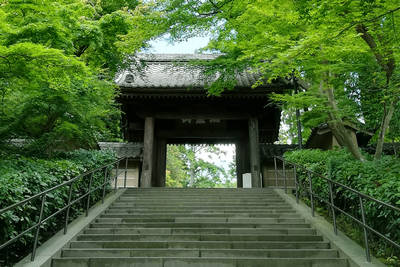
Enkakuji Temple
(admission 300¥, opening hours 8:00-16:30)
Engakuji Temple is considered to be number two of the five great Zen temples of Kamakura. It is located on the slopes of the wooded hills around Kita Kamakura Station, which are covered with many maple trees which turn red and orange in autumn and make this temple a popular place to enjoy the autumn atmosphere. The temple was founded in 1282 to pay homage to soldiers who fell during an attempted invasion of the Japanese archipelago a year earlier by the Mongols. The main entrance gate (Sammon Gate) dates from 1783 and is one of the oldest buildings. The Shariden contains the most precious object of the temple, that is a tooth of Buddha. Inside you will also find a tea house where you can enjoy green tea, amazake, but also vegetarian curry rice and the ancient tokoroten (seaweed jelly-based noodles).
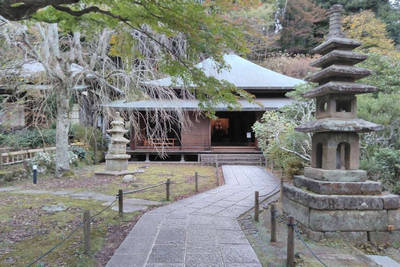
Tokeiji Temple
(admission 200¥, opening hours 8:00-16:30, until 16 from october to march)
Tokeiji Temple was founded in the year 1285 by a woman, Kokusan-ni, in memory of her late husband, the shogun Hōjō Tokimune. It was also called Enkiri Dera ("Temple of Divorces") as it became a refuge for all those women mistreated by their husbands. The temple allowed all those who settled there for at least 3 years to obtain a divorce, something that was almost impossible to obtain in the Japanese society of the time, and it maintained that power until 1873. Until 1902 the entrance remained forbidden to men. Inside there is a large cemetery.
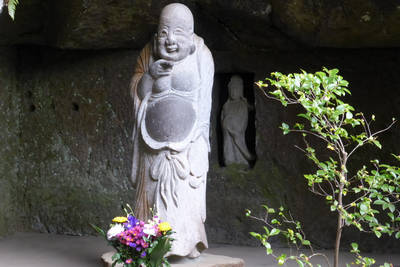
Jochiji Temple
(admission 200¥, opening hours 9-16:30)
Jochiji Temple is considered to be number four of the five great Zen temples of Kamakura. The buildings are nothing extraordinary, but the gardens that surround them are worth a stroll, among bamboo trees, flowers and an ancient cemetery. Some visitors rub the belly of a statue of Buddha Hotei ("Smiling Buddha") as a good luck charm.
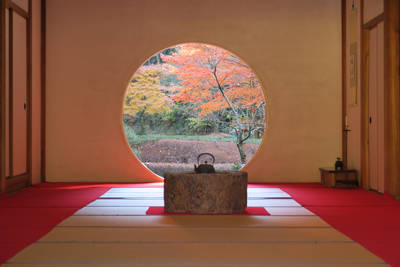
Meigetsu-in Temple
(admission 500¥, opening hours 9-16, 8:30-17:00 in june)
A Zen Buddhist temple also called Ajisai-dera, from the Japanese word "ajisai" which means hydrangeas in English. Around this temple there are in fact about 1500 of these blue flowers that bloom between June and July. The main hall (Hojo) is characterized by a photogenic circular window, behind which you can see the magnificent inner garden, generally not open to visitors, and full of irises. During the flowering of the irises in June and at the end of November it is also possible to visit the inner garden.
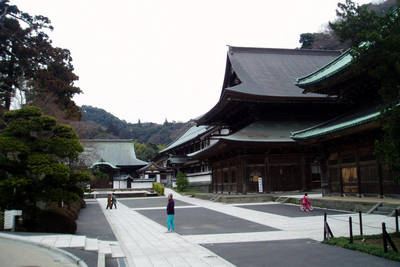
Kenchoji Temple
(admission 500¥, opening hours 8:30-16:30)
Kenchoji Temple is considered to be the number one of the five great Zen temples of Kamakura, and is also the oldest (1253). Despite being considerably smaller today than in the past, this temple still today gives the impression of being huge and includes numerous buildings within it. Don't miss the Hatto hall, the largest wooden temple in western Japan, and the main Hojo hall, from which you can admire a wonderful Zen garden designed by the master Musō Soseki (1275-1351), famous Zen monk, poet and garden designer of the time. Walking up the paths in the hills behind the temple, you can reach two panoramic viewpoints in about 20-25 minutes. The highest is located at a height of 100 meters and from there you can see both the city of Kamakura and, on clear days, Mount Fuji.
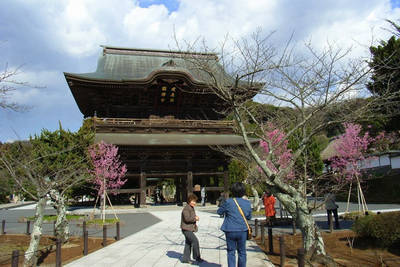
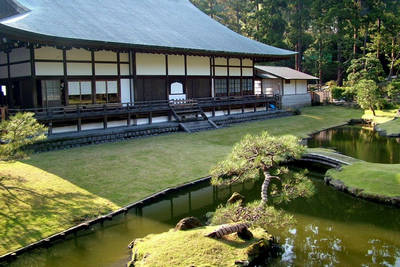 the entrance gate and the garden of the Kenchoji Temple
the entrance gate and the garden of the Kenchoji Temple
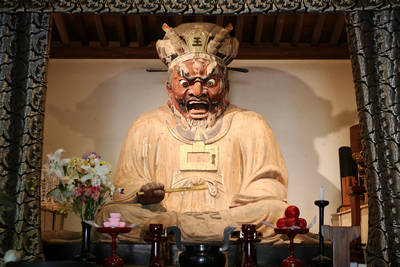
Ennoji Temple
(admission 200¥, opening hours 9-16)
Ennoji Temple is a small temple with a very sober style located in front of the much more famous Kenchoji Temple. In the main hall are the statues of the so-called "Ten Judges of Hell", who, according to an ancient rumor that spread in Kamakura many centuries ago, judged all living beings seven days after their death.
Near Kamakura station
The area around Kamakura station is the liveliest in the city. Just outside the station's east exit, on the left, you will find
Komachi Dori, the most popular shopping street full of restaurants and souvenir shops. It can be recognized immediately because at the entrance there is a very large red torii.
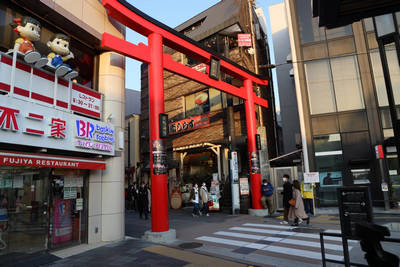
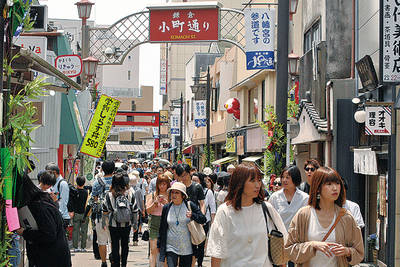 Komachi Dori
Komachi Dori
Parallel to Komachi dori, east side, there is another famous street called
Danzakura (or also
Wakamiya-oji). It is a tree-lined avenue surrounded by cherry trees and with a raised sidewalk in the middle of the road, leading to the entrance to the famous
Tsurugaoka Hachimangu shrine.
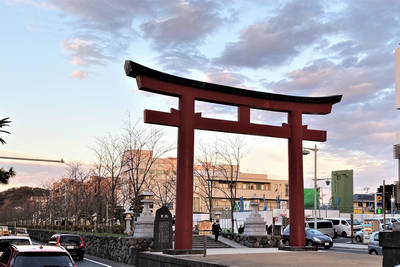
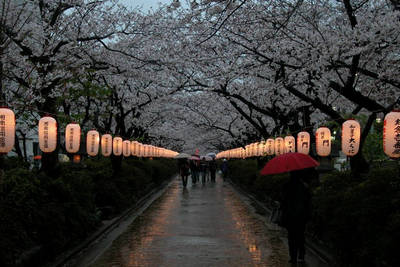 Danzakura
Danzakura
Tsurugaoka Hachimangu Shrine
(free admission, opening hours 5-21, 6-21 oct-mar)
Tsurugaoka Hachimangu is Kamakura's most important Shinto shrine. The main entrance of the temple is located at the end of Danzakura avenue, a few hundred meters east of Kamakura Station. Immediately after the entrance, to your right and left there are two ponds, with various symbolisms representing one the Minamoto Clan and the other the Taiwa Clan, two important rival families in Japanese history.
The main building, which also houses a small museum (admission 200¥), is located at the top of a staircase at the end of the shrine's central avenue. This place is very popular for weddings and even more so for New Year celebrations. It is in fact one of the most visited shrines in all of Japan with an average of 2 million visits between 1 and 3 January. Another very interesting event takes place in this place twice a year, on September 16 and on the third Sunday of April, and consists of a performance of Yabusame, or archery while riding a horse.
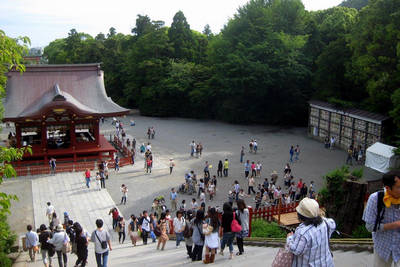
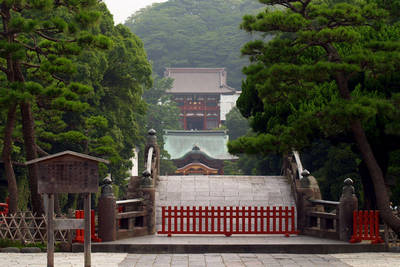 Tsurugaoka Hachimangu
Tsurugaoka Hachimangu
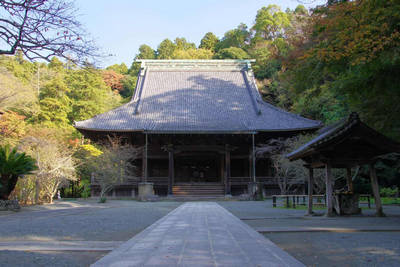
Myohonji Temple
(free admission, opening hours 9-17)
This temple is located in a very quiet area of Kamakura, with many religious buildings immersed in the green of the forest. It is snubbed by the vast majority of tourists and is recommended for those who want to visit an empty and silent Buddhist temple.
Temples and shrines west of Kamakura station
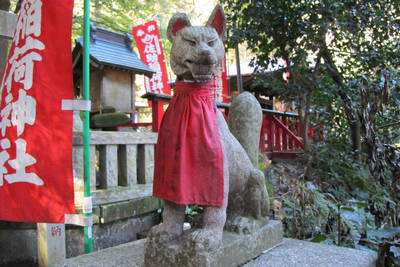 (free admission)
(free admission)
The Sasuke Inari is a shrine in an isolated area in the middle of the forest, characterized by fascinating mysteries and legends and filled with fox statues.
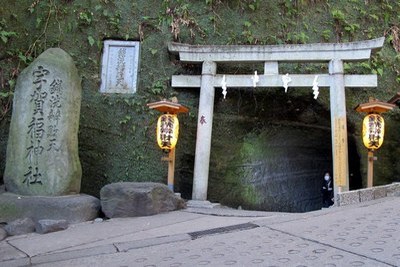 (free admission, opening hours 8:00-16:30)
(free admission, opening hours 8:00-16:30)
The Zeniarai Benten is one of the most popular Shinto shrines in Kamakura, where many faithful come to wash their money with the waters of a legendary hot spring that is said to be able to multiply the money.
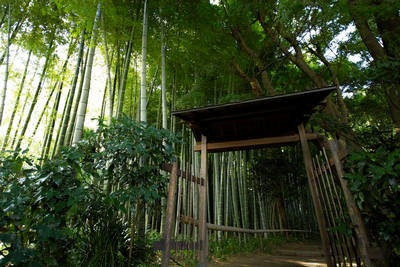
Eishoji Temple
(admission 300¥, opening hours 9-16)
Eishoji Temple is the only existing convent in Kamakura. It was founded in the early Edo period by Okaji no Kata, one of the favorite concubines of Ieyasu Tokugawa (1542-1616), one of the most important heroes in Japanese history. When the latter died, Okaji decided to build a convent where she could retire to pray for the rest of the soul of her lover. This too is a precious gem of Kamakura, out of the loop of mass tourism and recommended for those looking for quiet and peaceful places. Inside you can also admire a small bamboo forest and a place of worship carved into the rock.
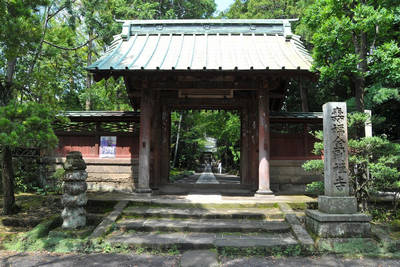
Jufukuji Temple
(usually closed to the public)
Jufukuji Temple is number three of Kamakura's five great Zen temples. It was founded by Hōjō Masako (1157–1225), to consecrate her deceased husband Minamoto no Yoritomo (1147–1199), founder of the Kamakura shogunate, who died falling from his horse. The temple is not generally open to the public, but many visitors usually make it to the temple entrance to admire and photograph the driveway.
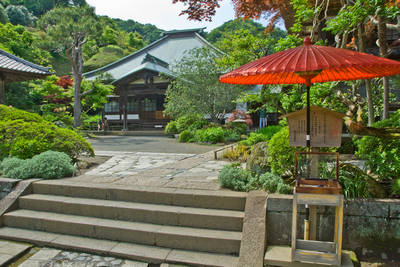
Kaizoji Temple
(free admission, opening hours 9:30-16:00)
Unlike almost all the other temples in the city, Kaizoji has the distinction of being one of the few to have been built when Kamakura was no longer the capital of Japan. The temple dates back to 1394, during the Muromachi period (1336-1573). Known as the "water temple", the Kaizoji is hidden among the houses of a residential area and features several religious buildings, a picturesque pond, and 16 mysterious wells. These are located inside a cave about 2 meters high, they are all the same size, with 70 centimeters in diameter and 40 in depth, and are uniformly arranged. It is not known precisely what these wells were used for.
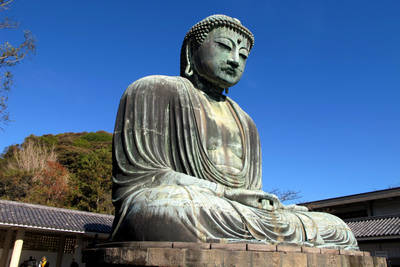 (admission 300¥, opening hours 8:00-17:30)
(admission 300¥, opening hours 8:00-17:30)
The Kotoku-in Temple houses Kamakura's most famous attraction, the Daibutsu (or Big Buddha), one of the largest bronze Buddha statues in the Japan.
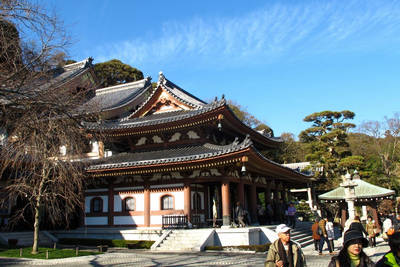 (admission 300 yen, opening hours 8:00-17:30, 8-17 in winter)
(admission 300 yen, opening hours 8:00-17:30, 8-17 in winter)
Hasedera Temple is one of the most visited Buddhist temples in the city, built on the slopes of a hill from whose terraces you can enjoy an enchanting view of the city of Kamakura and the beach.
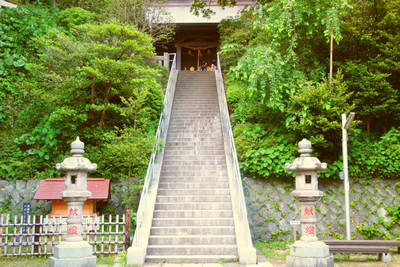
Amanawa Shinmei Shrine
(free admission)
The Amanawa Shinmei Shrine was founded in 710 and is considered the oldest Shinto shrine in Kamakura, although the buildings today are very recent and the last reconstruction dates back to 1998. It is dedicated to the sun goddess Amaterasu, and according to some documents the founder of the shrine would be the famous Gyōki priest. Its origin, however, is far from certain. Being little known among tourists, this shrine is usually empty.
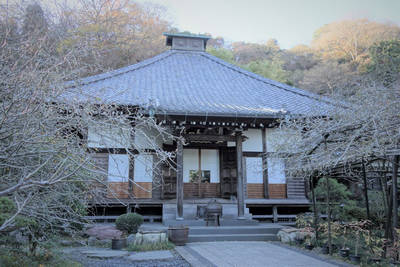
Kosokuji Temple
(admission 100¥, opening hours 8-17)
Kosokuji, located next to the much more famous Hasedera, is also known as "the temple of flowers", due to the many floral species that bloom every month of the year. Water lilies, camellia and calicanthus in January, plum trees in February, peach and yulan magnolia in March, cherry trees in April, azaleas and peonies in May, hydrangeas and irises in June, bellflower in July, the confederate rose in August, the amaryllidaceae in September, the gentian in October, the camellia sasanqua in November. Finally, in December the atmosphere is tinged with the typical autumn yellow and red colors.
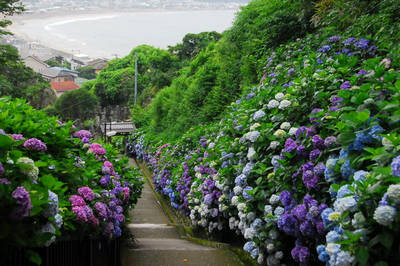
Joju-in Temple
(free admission)
A small temple unknown to most people on the top of a hill. To access it you have to climb a staircase of 108 steps, surrounded by hydrangeas on both sides. From mid-June until the beginning of July, you can enjoy a fantastic view of the sea, Kamakura beach and blooming hydrangeas. In the courtyard there are two very photogenic bronze statues, in particular the one depicting the priest Kukai (founder of the Shingon sect) in the act of begging.
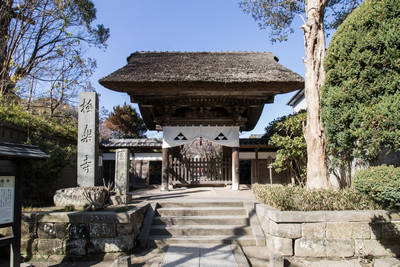
Gokurakuji Temple
(free admission, opening hours 9-16:30)
Gokurakuji is a very peaceful little temple with many colorful flowers and several interesting statues including a stone representation of the famous "Three Wise Monkeys". The thatched roof of the main entrance door is also very interesting, a feature not very common among Buddhist temples.
Temples and shrines east of Kamakura station
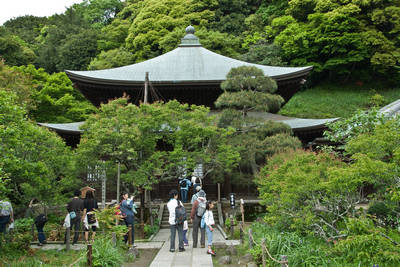
Zuisenji Temple
(admission 200¥, opening hours 9-17)
Zuisenji Temple is one of the most beautiful, as well as one of the most difficult to reach in Kamakura. It was founded by Muso Kokushi, one of the leading Zen masters of his time and legendary garden designer, including the rock garden of this temple. It is located in the far eastern part of the city, about 50 minutes walk from Kamakura station, on top of an isolated hill and surrounded by woods. It is famous for both its vegetation and its particular Zen rock garden. The beauty of its plants, including a large number of plum trees, has earned it the nickname "Temple of Flowers" since ancient times. The Zen garden was partly created by excavating a vertical rock wall.
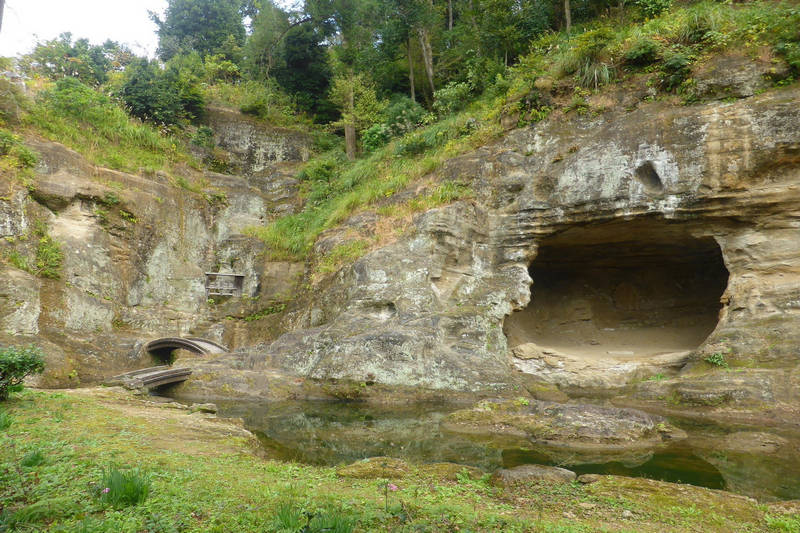 the rock garden of the Zuisenji Temple
the rock garden of the Zuisenji Temple
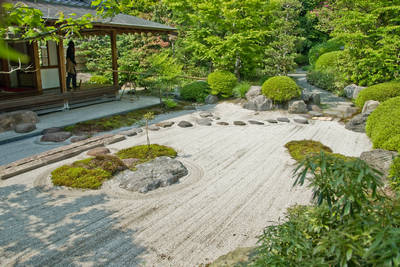
Jomyoji Temple
(admission 100¥, opening hours 9:00-16:30)
Jomyoji Temple is a Zen temple in the hills of eastern Kamakura, ranking fifth among the five great Zen temples of Kamakura. This was once huge, but over the centuries most of the buildings have been destroyed. Very characteristic is the tea house inside, where you can sit at the tables overlooking the rock garden of the temple. Strange as it may seem, walking a path that climbs up the hill leads to a western-style restaurant overlooking the city.
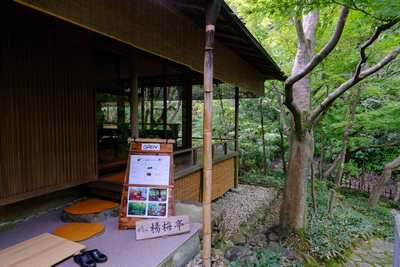
Ichijo Ekan Sanso
(admission 500¥, opening hours 10-16, closed on monday and tuesday)
This building was originally built in the 17th century in the Nishigamo area of Kyoto by Ichijo Ekan, the ninth son of Emperor Go-Yozei. It was a tea house for the ruling family of the time. In 1959 the building was relocated to Kamakura and the gardens were faithfully recreated to the originals, also using the same stones. By visiting this place you have the rare opportunity to experience the Kyoto of 1600 while staying in Kamakura. Inside there is a delightful cafe (Yamamomo tei) overlooking the surrounding forest, serving matcha tea, coffee, traditional sweets and a distinctive yuzu cider.
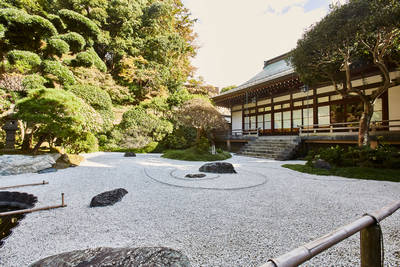
Hokokuji Temple
(free admission, opening hours 9-16)
Hokokuji is a small temple of the Rinzai sect of Zen Buddhism. At first glance it would not seem anything sensational, but if you just walk for a few minutes inside you'll reach one of the most fascinating places in Kamakura. Behind the main building there is indeed a beautiful and dense bamboo grove with over 2000 dark green stems. After crossing it all, you will arrive at a tea house where you can sit and enjoy a cup of tea with sweets overlooking the bamboo trees. Entrance to the temple is free, while to access the wood you need to pay 300¥. A cup of tea costs 600¥.
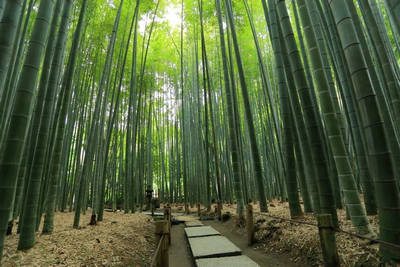
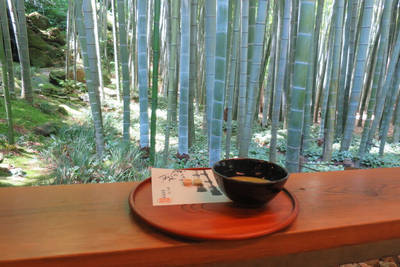 the bamboo forest and tea house of Hokokuji Temple
the bamboo forest and tea house of Hokokuji Temple
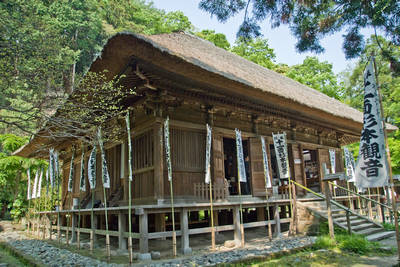
Sugimoto-dera Temple
(admission 200¥, opening hours 8:00-16:30)
Sugimoto-dera is the oldest Buddhist temple in Kamakura, founded in 734, well before the Kamakura shogunate was established. The elements that most attract the attention of visitors are a long, moss-covered staircase at the entrance, and the main building of the temple, a nine-square-meter wooden building dating from 1677, with a thatched roof that is replaced by over three centuries every about 20 years.
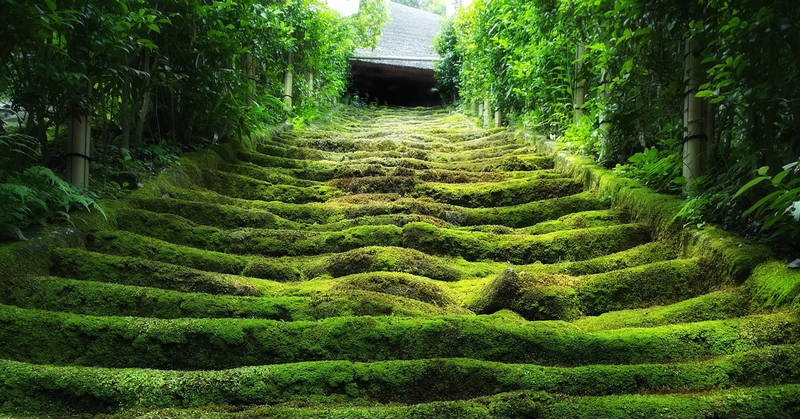 the moss-covered stairs of the Sugimoto-dera Temple (credits)
the moss-covered stairs of the Sugimoto-dera Temple (credits)
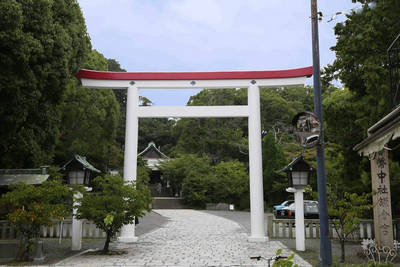
Kamakura-gu Shrine
(free admission, opening hours 9:00-16:30)
A Shinto shrine erected by Emperor Meiji in 1869, in honor of Prince Morinaga, who in 1335 was first imprisoned and then beheaded in the place where the shrine is today. Before the execution, Morinaga was held captive for nine months in a small cave that still exists today, in the rock face behind the shrine. Another much photographed feature of this shrine is its large sacred gate (torii) at the entrance, painted in an unusual white color with a red stripe at the top.
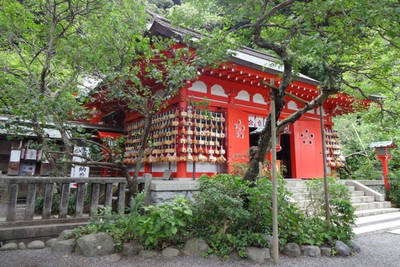
Egara Tenjin Shrine
(free admission, opening hours 7:30-18:30)
There are many Shinto shrines called Tenjin (or Tenmangu) in Japan and all are dedicated to the memory of Michizane Sugawara (845-903), patron deity of studies. The Egara Tenjin of Kamakura is one of the three largest Tenjin shrines in Japan, founded according to legend by an unknown priest in 1104. It is a place of prayer for many students, especially for those who prepare for the entrance exam for university. Plums are the symbolic tree of all Tenjin shrines and this Kamakura shrine also has about forty plum trees on its grounds that bloom in spring.
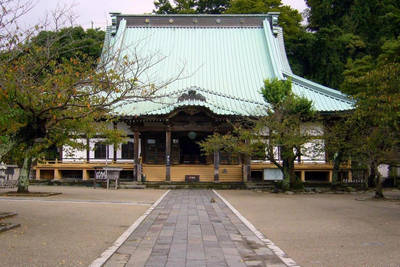
Komyoji Temple
(free admission, opening hours 7-16)
The Komyoji is located at the west end of the city's long beach, and one of the few temples built near the sea. The entrance door and the main hall of the temple are striking for their large size, well beyond the average of Kamakura temples. The temple also features some cherry trees that bloom in spring, a pond with lotus flowers, an overly opulent Buddhist style altar, and an unusual rock garden. Rock gardens are in fact a common element in Zen Buddhist temples, while this temple belongs to the Jodo Buddhist sect.
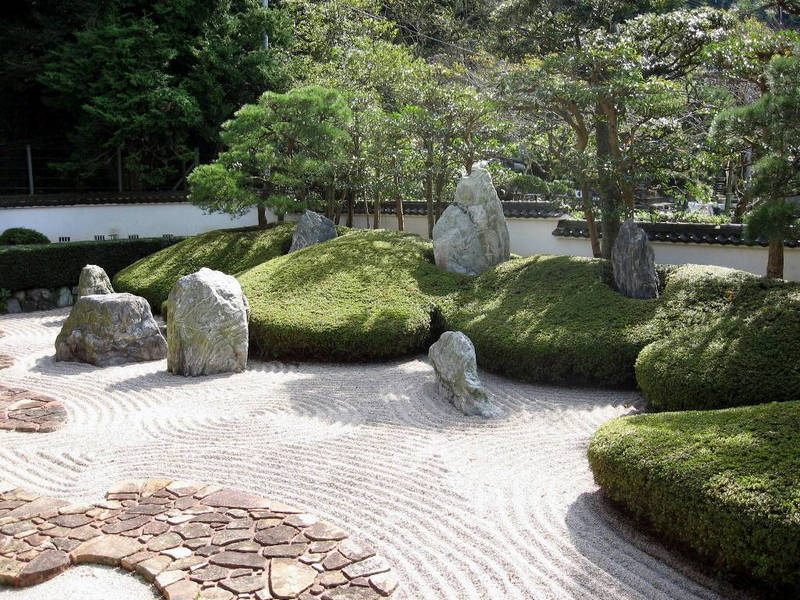 the rock garden of the Komyoji Temple
the rock garden of the Komyoji Temple
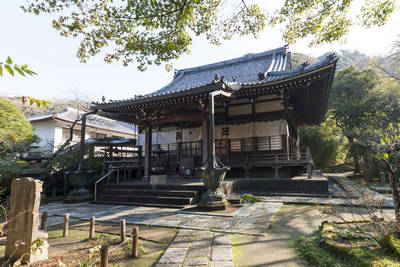
Ankokuronji Temple
(admission 100¥, opening hours 9:00-16:30, closed on monday)
Ankokuronji Temple is one of several temples of the Nichiren Buddhist sect in the hills in the southeast of the city. Nichiren himself (1222-1282) lived for a few years in this temple which he founded in 1253. The temple itself is nothing special and is never crowded, but around there is a path that climbs up the wooded hills, with a beautiful view of the city of Kamakura, the sea, and passing a cave with some Buddhist statues inside.
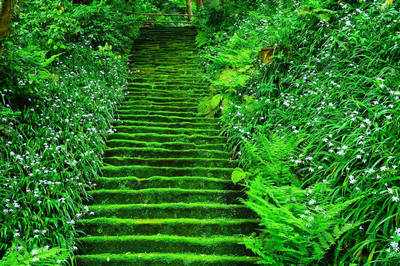
Myohoji Temple
(admission 300¥, opening hours 9:30-16:30, closed on february)
The Myoho-ji temple of the famous Nichiren Buddhist sect is one of the most fascinating Buddhist temples in Kamakura. The temple is most famous for its long stairways of 50 steps covered with moss. For this reason it is sometimes nicknamed Kokedera (literally "moss temple" in Japanese). The staircase leads to two caves, one of which contains a statue of the monk Nichiren, founder of the homonymous sect. However, the moss-covered staircase is not passable, another one must be used to climb the hill.
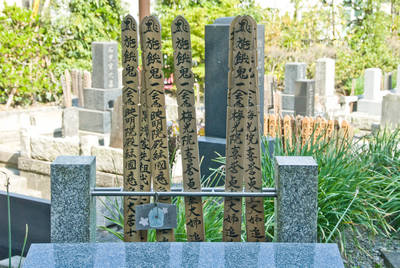
An-yo-in Temple
(admission 100¥, opening hours 9-16)
A small temple known above all for the azalea flowers that surround it and which bloom in spring and for the small cemetery attached to the temple, where the world-famous director Akira Kurosawa rests.
Coast and beaches
Kamakura is also one of the most popular locations in the Tokyo area for seaside tourism. The city is in fact a popular destination during the summer, usually in the months of July and August, with equipped beaches and the sea filled with Japanese in costume, although sunbathing is not part of the local culture and it is not uncommon to see people at the beach wearing clothes. The water is bad for swimming (high, not clean), but good for some water sports. During the rest of the year the beaches get empty but the waters are still full of people surfing, the area is in fact quite windy.
City beaches of Zaimokuza and Yuigahama
The main beaches, very wide and with a sea usually rather calm because inside a gulf, are Zaimokuza and Yuigahama, east and west respectively of the river that runs through Kamakura (Namerigawa, 滑川), and are easily accessible on foot from anywhere in the city by walking south. Hase and Yuigahama station of the Enoden Line are very close to Yuigahama beach.
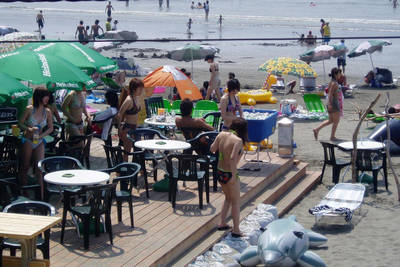
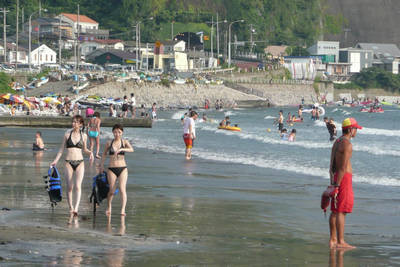 the beaches of Kamakura in the summer
the beaches of Kamakura in the summer
Inamuragasaki
To the west of Yuigahama, the Inamuragasaki cape closes the gulf. This is a place that has significant historical importance, in fact it represented one of the natural defenses of Kamakura when the city was the capital. In 1333 the troops of Nitta Yoshisada managed to pass it, starting the siege of the city that would lead to the end of the Kamakura Period. At the tip of the promontory there is now Inamuragasaki Koen, a public park with a breathtaking view of the sea, the beach, the island of Enoshima and in the distance Mount Fuji. It is no coincidence that it is always full of photography enthusiasts, especially at sunset.
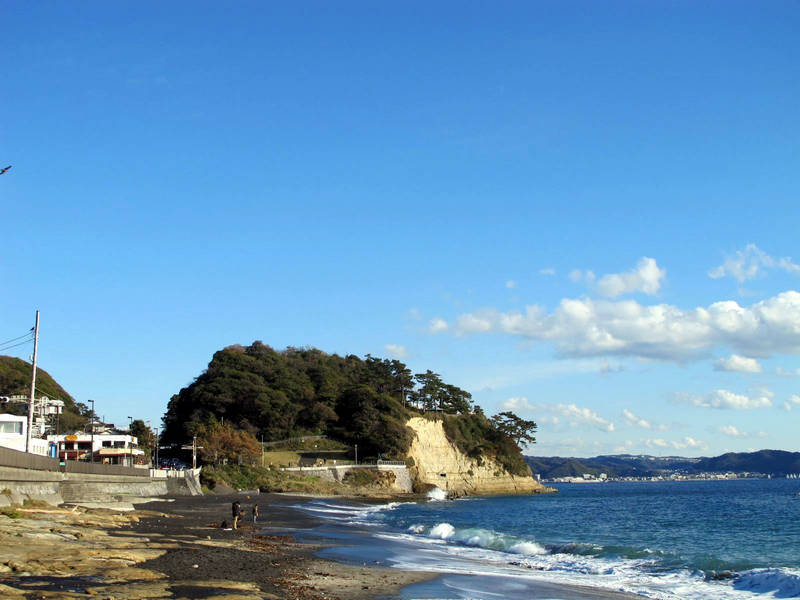 Inamuragasaki from Shichirigahama beach
Inamuragasaki from Shichirigahama beach
Shichirigahama Beach
To the west of Inamuragasaki, another beach, Shichirigahama, stretches for about 4 km, almost reaching Enoshima. It is considered to be one of the 100 most beautiful scenic beaches in Japan. Covered with black volcanic sand, it is possible to see Cape Inamuragasaki, Enoshima Island and sometimes Mount Fuji from here. It is not very popular with swimmers due to its deep waters, while it is a favorite with surfers as it is more open and therefore windier than the others. In the spring and summer months it is filled with people relaxing in the open air, and the street in front of the beach is filled with people walking and drinking and eating something in the many bars and restaurants along the coast.
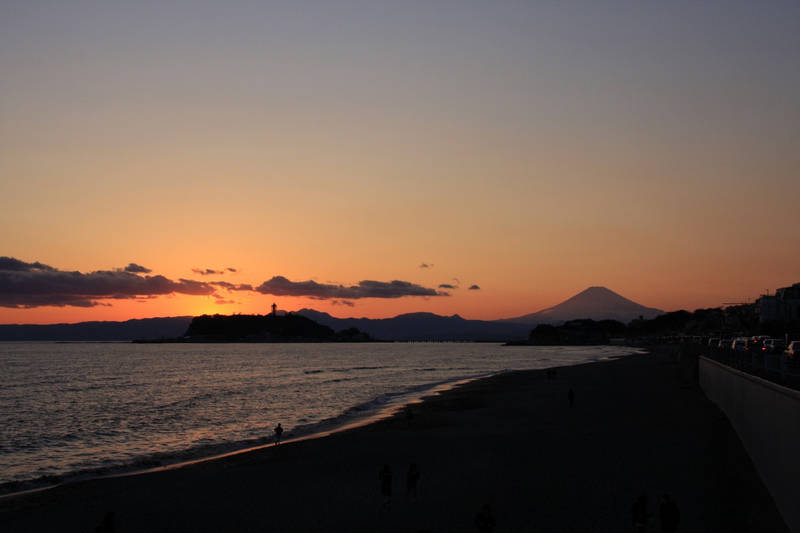 Shichirigahama beach at sunset, in the distance the island of Enoshima and Mount Fuji
Shichirigahama beach at sunset, in the distance the island of Enoshima and Mount Fuji
Where to stay in Kamakura
Oddly, there are no large hotels or even business hotels in the center of Kamakura. Given the proximity to Tokyo and Yokohama, very few people decide to spend a night in Kamakura and most tourists usually only take a day trip, or stay along the coast in front of Enoshima. Until a few years ago, the possibilities of accommodation in this town were counted on the fingers of one hand. In recent years, thanks to the tourism boom, the city center has been filled with guest houses and other small structures often obtained from former homes.
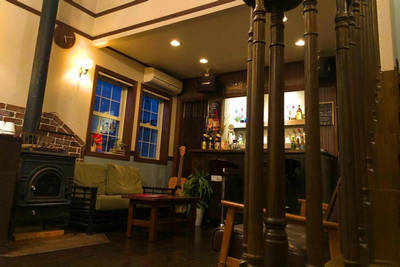 A small guest house very friendly to foreigners, 150 meters from the seafront, 700 meters from the famous Great Buddha, and 200 meters from Hase station, from which you can easily move along the coast to Enoshima or reach Kamakura station in 5 minutes. The property offers bunk beds in mixed dorms and private double rooms. Inside the structure there is also a small lounge bar (cocktails 500¥) open to external customers, therefore a great place to meet other people. A place suitable for young travelers looking for a cheap place and new friends.
Price range: 3,500-7,000¥.
A small guest house very friendly to foreigners, 150 meters from the seafront, 700 meters from the famous Great Buddha, and 200 meters from Hase station, from which you can easily move along the coast to Enoshima or reach Kamakura station in 5 minutes. The property offers bunk beds in mixed dorms and private double rooms. Inside the structure there is also a small lounge bar (cocktails 500¥) open to external customers, therefore a great place to meet other people. A place suitable for young travelers looking for a cheap place and new friends.
Price range: 3,500-7,000¥.
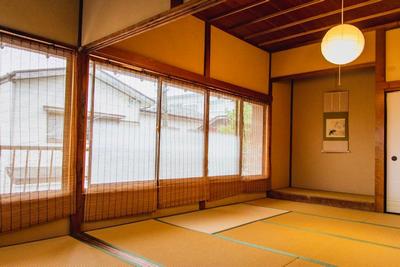 A typical Japanese house converted into a small guest house, which is also located near the waterfront, the Great Buddha, and Hase station. Here you can sleep in a room shared with the other guests, sleeping on the floor with futon beds placed on the tatami floor. The kitchen of the house is available to guests. An opportunity to sleep in a real traditional Japanese house.
Price range: 3,500-7,000¥.
A typical Japanese house converted into a small guest house, which is also located near the waterfront, the Great Buddha, and Hase station. Here you can sleep in a room shared with the other guests, sleeping on the floor with futon beds placed on the tatami floor. The kitchen of the house is available to guests. An opportunity to sleep in a real traditional Japanese house.
Price range: 3,500-7,000¥.
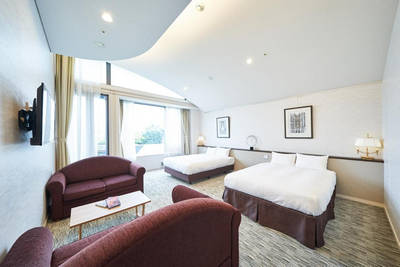 Webase Kamakura is one of the few large accommodations in the city center. It is located a few meters from Yuigahama beach and the station of the same name. Kamakura station is just over a quarter of an hour on foot or 4 minutes by train. Although it presents itself as a hostel, calling it that is definitely an understatement. The interior of this hostel is in fact modern, with large common areas including a public thermal bath, and many other services. Very popular are the yoga classes also organized on the nearby beach. The property offers beds (very large!) in shared rooms, but also single and double private rooms and also big rooms for families or groups of friends up to six people.
Price range: 5,000-20,000¥.
Webase Kamakura is one of the few large accommodations in the city center. It is located a few meters from Yuigahama beach and the station of the same name. Kamakura station is just over a quarter of an hour on foot or 4 minutes by train. Although it presents itself as a hostel, calling it that is definitely an understatement. The interior of this hostel is in fact modern, with large common areas including a public thermal bath, and many other services. Very popular are the yoga classes also organized on the nearby beach. The property offers beds (very large!) in shared rooms, but also single and double private rooms and also big rooms for families or groups of friends up to six people.
Price range: 5,000-20,000¥.
How to get to Kamakura
Kamakura is easily accessible without changes from various Tokyo stations, via the JR Yokosuka line and the JR Shonan-Shinjuku line. Both of these lines stop at both Kita-Kamakura and Kamakura station, the two railway stations of reference for those arriving in the city. Kita-Kamakura station is a small station north of the city, but surrounded by numerous temples, some of which are also very famous. Kamakura station is the main station of the city, and the interchange station with the local Enoden line for the area of Enoshima.
JR Yokosuka line
This line connects Tokyo station with Kita-Kamakura and Kamakura in about an hour (940¥), also passing through important stations such as Shimbashi, Shinagawa, e Yokohama station (24 minutes, 350¥).
JR Shonan-Shinjuku line
This line connects Ikebukuro with Kita-Kamakura and Kamakura in about an hour (940¥), also passing through important stations such as Shinjuku, Shibuya and Yokohama. However, not all trains on this line are directed to Kamakura, but only those bound for Zushi. The other trains of this line end their journey at Ofuna station, where you can change to the JR Yokosuka line to reach Kamakura in a few minutes.
Via the Odakyu Lines
Another very good alternative especially if you are planning to visit Enoshima too, is to use the Odakyu Railways. This private company connects Shinjuku with Fujisawa station in about an hour (600¥). From Fujisawa you can then take the Enoden Line which also stops at Enoshima station (it is therefore advisable to visit Enoshima first and then Kamakura), and finally Kamakura station. The most convenient way to take advantage of the Odakyu lines is to buy the Enoshima Kamakura Free pass.
Enoshima Kamakura Free Pass
This pass is the cheapest way ever to visit Kamakura and Enoshima or even just Kamakura, although in the latter case the total travel time is much longer than on the JR lines. You can buy it at any Odakyu station, in particular it is easy to buy it at Shinjuku station. It costs 1520¥ and offers a return ticket from Shinjuku to Fujisawa as well as unlimited use of the Enoden Line. Via this short local line you can travel between Enoshima and Kamakura as often as you like. Some intermediate stops along the way are also located near tourist spots, such as Hase station near the Big Buddha or Inamuragasaki station near the promontory of the same name and the nearby beach.
Map of Kamakura, Kanagawa
Guided tours, activities and other things to do
If you are planning a trip to Japan and you want to do something more than just visiting famous places and monuments, we suggest you to use Rakuten Travel Experiences.
How to use Rakuten Travel Experiences
Rakuten Travel is a very useful website to enrich your travel experience, especially if you are going solo or it's your first time in Japan.
Because of the language barrier (and more), in Japan it is very difficult to interact with the locals and to get off the tourist track.
Thanks to Rakuten Travel you can find a lot of interesting and sometimes unique guided tours and activities all over Japan (and not only in Japan), that you would otherwise never be able to enjoy.
But there's more: on Rakuten Travel you can also buy tickets for several famous attractions, events, transportation and other useful services for tourists. Last but not least, you can reserve a table in hundreds of restaurants.
Some examples
Take a look at Rakuten Travel Experiences
You may also be interested in























 the moss-covered stairs of the Sugimoto-dera Temple (credits)
the moss-covered stairs of the Sugimoto-dera Temple (credits)






 A small guest house very friendly to foreigners, 150 meters from the seafront, 700 meters from the famous Great Buddha, and 200 meters from Hase station, from which you can easily move along the coast to Enoshima or reach Kamakura station in 5 minutes. The property offers bunk beds in mixed dorms and private double rooms. Inside the structure there is also a small lounge bar (cocktails 500¥) open to external customers, therefore a great place to meet other people. A place suitable for young travelers looking for a cheap place and new friends.
Price range: 3,500-7,000¥.
A small guest house very friendly to foreigners, 150 meters from the seafront, 700 meters from the famous Great Buddha, and 200 meters from Hase station, from which you can easily move along the coast to Enoshima or reach Kamakura station in 5 minutes. The property offers bunk beds in mixed dorms and private double rooms. Inside the structure there is also a small lounge bar (cocktails 500¥) open to external customers, therefore a great place to meet other people. A place suitable for young travelers looking for a cheap place and new friends.
Price range: 3,500-7,000¥.
 A typical Japanese house converted into a small guest house, which is also located near the waterfront, the Great Buddha, and Hase station. Here you can sleep in a room shared with the other guests, sleeping on the floor with futon beds placed on the tatami floor. The kitchen of the house is available to guests. An opportunity to sleep in a real traditional Japanese house.
Price range: 3,500-7,000¥.
A typical Japanese house converted into a small guest house, which is also located near the waterfront, the Great Buddha, and Hase station. Here you can sleep in a room shared with the other guests, sleeping on the floor with futon beds placed on the tatami floor. The kitchen of the house is available to guests. An opportunity to sleep in a real traditional Japanese house.
Price range: 3,500-7,000¥.
 Webase Kamakura is one of the few large accommodations in the city center. It is located a few meters from Yuigahama beach and the station of the same name. Kamakura station is just over a quarter of an hour on foot or 4 minutes by train. Although it presents itself as a hostel, calling it that is definitely an understatement. The interior of this hostel is in fact modern, with large common areas including a public thermal bath, and many other services. Very popular are the yoga classes also organized on the nearby beach. The property offers beds (very large!) in shared rooms, but also single and double private rooms and also big rooms for families or groups of friends up to six people.
Price range: 5,000-20,000¥.
Webase Kamakura is one of the few large accommodations in the city center. It is located a few meters from Yuigahama beach and the station of the same name. Kamakura station is just over a quarter of an hour on foot or 4 minutes by train. Although it presents itself as a hostel, calling it that is definitely an understatement. The interior of this hostel is in fact modern, with large common areas including a public thermal bath, and many other services. Very popular are the yoga classes also organized on the nearby beach. The property offers beds (very large!) in shared rooms, but also single and double private rooms and also big rooms for families or groups of friends up to six people.
Price range: 5,000-20,000¥.